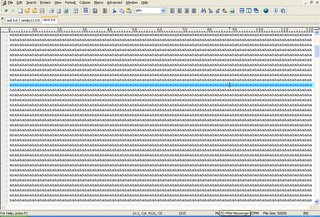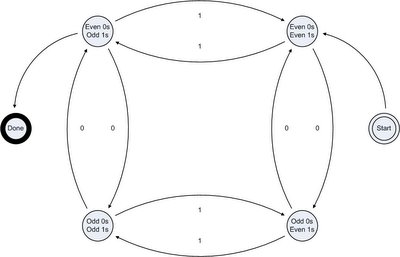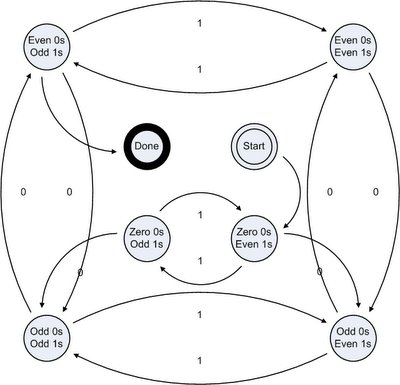So, I've now had midterms in every one of my classes this semester - biochemistry, biology, biology lab, computer science, and history. It seems this semester I'm having extraordinarily bad luck at getting teachers with both a good sense of logic and a good sense of time.
The first of these tests was in biochemistry. The teacher had very clearly said, about a week before the test, what material would and would not be on the test (that is, none of the stuff in lecture less than a week before the test would be on the test). She even very specifically listed a couple topics in particular that would not be on the test. Guess what was worth 15% of the grade on the test? However, when she saw that I'd written on the test that she said that wouldn't be on the test, she decided to multiple everyone's test scores by 1/0.85.
But that wasn't the only problem. I noticed that at the end of the test, when she told everybody to turn in their tests now, only 3 or 4 people (out of a class of at least 30) had left early. I reasoned that if only 10% of the class had left early, that probably meant that a good 65%+ of the class or more hadn't even finished the test. I sent her an e-mail to that effect, saying that the test was too long. I got back this reply (actual quote taken from the e-mail):
at least 30-40% of the class had finished the test before time was up thus I do not believe that there was any problem with the length of the exam (except that it was probably too short)...
Okay, moving on...
Next up: biology. This test had more or less the same problem, only worse: few, if any, of the students had time to complete the test (indeed, after we handed in the tests I heart just about everybody at my table complaining that they weren't done). On the test was a wide variety of questions, but one, worth about 20% of the test (which means you should be able to answer it in about 20 minutes), was really the deathblow to reason and sanity. It went something like this (recalling from memory):
You are working in a barn, and sit down for a moment. When you sit down, you find that you've sat on a rusty nail, and deeply impaled yourself. An additional concern to you is that you have previously had a skin infection, which might have managed to get in the wound. Explain how the immune system would respond to this, including specific cells, locations of occurrence, chemicals, and chemical receptors.
Okay... macrophages, neutrophils, cytokines, inflammation, complement, lymph system, phagocytosis, antigen presentation, B-cell proliferation/differentiation, memory cells, plasma cells, antibody production, and a few other assorted things. Well that answer covers a good 2/3 of everything we'd learned in class up till the test. A succinct person like myself might be able to squish the answer into 3 full pages (had I had the time); other students had already gone beyond that before running out of time (and still didn't get near all of it covered). Honestly, this is about as much material as I expected to have to recite on the entire test; but then, maybe I'm too sane to be a teacher.
Next up was computer science. Nothing much to see here, other than more of the same: too freakin long. Again only 2 or 3 people out of a class of at least 30 had turned in their tests before being forced to, and again I heard people all over the room saying "I didn't have time to finish!" Somehow (probably due to the fact that 2 out of 2 of the previous tests had been this way) this wasn't so very surprising.
This was the same test that one grammar question was on; the teacher is a pretty cool guy (imagine a slightly nerdy Howie Mandel; he even looks like Howie Mandel), but he really could stand to get a handle on the fourth dimension.
Next was the history test. This was the only one of the tests that I was actually satisfied with my answers (and didn't feel like I could have done better if I'd had more time). Although a bit of that is due to the fact that we knew exactly what was on the test before we took it; the teacher made a study guide (about 3 times as long as the test) which included all of the questions on the test, as well as about twice as many questions that weren't (though we didn't know which was which ahead of time).
Then today came the biology lab test. This test seemed to be the worst of all of them, but that could just be because I've forgotten some of the specifics of other tests (which were 1-2 weeks ago). As this post is already way too long, I'll limit my complaints to only a few of the problems with this test. Let's start with this gem (rough recall of the question from memory: "Explain what the difference between confocal microscopy and fluorescent microscopy is, and the advantages of confocal microscopy." Mu? How does one explain the difference (and the superiority/inferiority) between two things that aren't mutually exclusive?
A second example (the last one, as this post is already hideously long) is one involving a graph of "precipitation" (no units given) vs. "antigen" (mg). The question asks you to calculate how much antibody there is at a given point in the graph, giving the answer in mg/ml. A bit of explanation is in order for this. This is a graph you would make using a spectrophotometer (hence the lack of units for the y axis); you would then use a standard curve to calculate the concentration of the unknown based on its absorption. Usually the x axis is in mg/ml, but this could be calculated if the volume was known (since the weight is known). I go up to the teacher, and the dialog goes something like this:
Me: There isn't enough information to answer this problem
Her: Huh? Never had a problem with it before...
Me: This graph and the data table are in mg. The answer requires the volume to be known, and it isn't given in the question.
Her: *takes a minute or two to look over the question* Oh. Well, I guess just assume that was supposed to be "mg/ml".
Me: Also, this y axis of this graph has no units
Her: So? That's how we always do it.
Me: We always have a standard curve. There is no standard curve here.
Her: *takes a minute or two to look at the question* Oh. I guess that axis would have to be mg/ml, then.
If you're looking to get a
space craft to Mars, I can give you the name of somebody not to employ.





